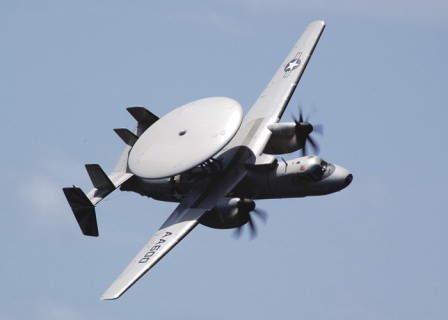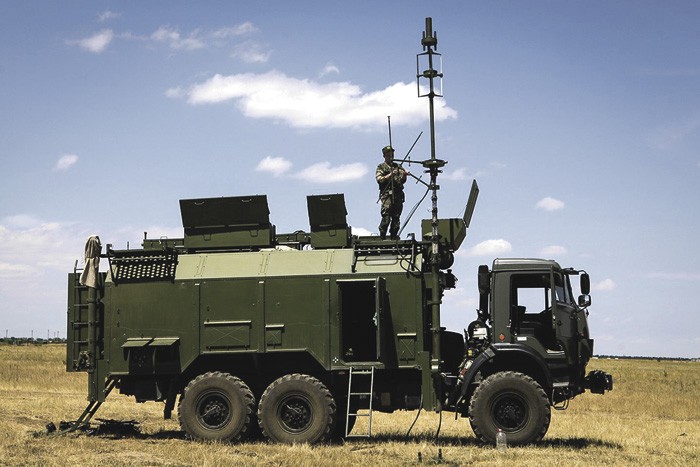
Самолет Northrop Grumman E-2C Hawkeye, equipped with AWACS system. Photo from the site www.navy.mil
West still doesn't believe, that for ten years, Russia's use of electronic warfare (electronic warfare) in the war in Georgia in 2008 year and in Syria in 2018 year really and radically changed the situation. At present, the electronic warfare of Russia severely affects the possibility of US and NATO aviation, Israel in Syria. Russia will not fully disclose its capabilities in electronic warfare (offensive and defensive), lest the adversary fully recognize its capabilities.
The strength and means of electronic warfare in operations in the Caucasus
Georgian radar station in the Gori region, donated by Americans, controlled the entire territory of the Caucasus. Thanks to radar benefits, Georgia tracked all cell phones in the conflict zone and launched fire strikes on them. Radar detection, warning and control of hostilities of the Georgian air defense forces and equipment was carried out by combat control authorities and stationary radar posts according to information from radar 36D6, P-37, 5H87, P-18, 19Ж6, PRV-9, PRV-11, PRV-13, ASR-12, as well as various French-made radars in the areas of Poti, Hoofed animals, It burns, Tbilisi, Marneuli.
Georgia receives Skywatcher early warning system for air attack and anti-aircraft guns from Americans, which was integrated into the system of obtaining information from the American means of tracking. Amid the superiority of Russian aviation, Georgian air defense applied tactics, like that, which the Yugoslavs used to protect against NATO air raids: temporary focal inclusion of air defense systems and organization of ambushes on the alleged flight routes of Russian aviation with the Tor-M1 and Buk mobile anti-aircraft systems. It was difficult to counter this tactic.
Russia did not use electronic warfare to suppress Georgian air defense systems. There was no aviation advantage during the first day, there were no aircraft pilots in the troops, which allowed the Georgian MLRS and artillery over 14 hours to fire freely in Tskhinval. Air Force task forces did not allocate 2–3 people for combined arms units with the parallel deployment of KP and ZKP, in this regard, there was no real aviation control. The forces of operational radio intelligence were allocated from the Air Force and transferred to the direct subordination of the GRU, which did not actually assist the Air Force intelligence. Lacking reliable data on the location of active air defense systems of Georgia and the organization of their management, The air force was forced to act at their own peril and risk. The loss on the first day of the conflict of two combat aircraft, and on the second (According to various estimates) - two to four vehicles caused shock at the Air Force command. The destruction of the Tu-22 Georgian air defense demonstrated the inefficiency of the tactics of combat use of the Russian air force. They had an overwhelming superiority in power., but raids were carried out in small groups - 2–4 aircraft. It means, that the Air Force did not provide reliable destruction of these targets, as they did not cover the shock machines with EW aircraft, did not allocate special aircraft to destroy detected air defense systems, and most importantly - put pilots at great risk.
EW facilities for aircraft and helicopters, planned for combat use in Georgia, did not fully meet the requirements for providing protection against air defense systems. Besides, taking into account the mountainous terrain, it was simply impossible to cover, by airplanes and EW helicopters, the combat formations of attack aircraft throughout the flight route. The EW and SPO Su-24M equipment was recognized as incapable of conducting combat operations in mountain conditions and withstanding modern domestic air defense systems (Soviet) production. The training of crews of the Su-24M and MP recognized as unsatisfactory, especially in the field of navigational tasks and navigation. Significant shortcomings were noted in ensuring the survivability of aviation. These include: lack of reconnaissance aircraft, capable of conducting detailed radio engineering reconnaissance in real time with high accuracy in determining radar coordinates; mismatch of the frequency ranges of the air-to-radar missile-carrier systems and the Soviet-made air defense radar systems; lack of control and target designation equipment; insufficient number of jammers and their short time in the jamming area; lack of electronic warfare of group defense from battle formations. That is why the planning of the first air strikes, special flights were carried out without taking into account and a detailed assessment of the Georgian air defense capabilities in detecting and hitting aircraft and helicopters with guided weapons and anti-aircraft artillery in a specific direction. Specialists in EW services were not sufficiently involved in aviation planning. Space control of war zones, KP, PU, identified radar positions, Georgian air defense system was practically not carried out. Specialists in EW services were not sufficiently involved in aviation planning. RTR was carried out irregularly and not by all means, without setting passive and active interference to clarify the electronic environment, communication and control system status, dislocation radar RTV and SAM, airfield airfields. But even in these conditions, the Russian airborne radio-electronic reconnaissance equipment of the Air Force EW already on the first day of hostilities revealed the actions of the Osa and Buk air defense systems in the Gori and Tbilisi regions.

The Defense Ministry told about the ineffectiveness of the US air defense in Saudi Arabia
The actions of special aircraft and EW / RTR helicopters were considered competent, but the Soviet-made An-12PP equipment complex (not export) outdated and does not work against standard radars and warning and communications. In military operations were involved 2 AWACS A-50. Evaluation of the actions of AWACS aircraft: relatively high efficiency of the main airborne complexes in mountainous conditions, satisfactory training of crews and operators. At the same time, low reliability of individual elements of on-board equipment during long-term operation is noted, outdated and inefficient communication system with escorted and guided sides, complete non-compliance with technical and special service standards.
The forces of EW aircraft and helicopters of the Russian Air Force detected the operation of a large number of different frequency ranges of the Georgian radar 36D6, P-37, 5H87, P-18, 19Ж6, PRV-9, PRV-11, PRV-13, ASR-12. In the areas of Gori, Tbilisi and Marneuli active use (inclusion and long work on air) SAM "Buk-M1", "Osa-AKM", C-125, MANPADS of the "Arrow" type, "Needle" and "Stinger", and also recorded the work of the ROC air defense missile systems S-200 and "Circle". Thus confirmed, that the Georgian air defense group is functioning and ready for warfare. At the same time, interference was observed in our electronic suppression of the enemy’s RES even for our 5N84 type RES, 5H87, P-18, P-37, placed at a distance of 100-120 km from the zone of production by An-12PP aircraft.
NATO and US Rep forces and intervention in Libya
The main objective in the initial period of electronic warfare was to suppress air defense systems and means, preceding the destruction of cruise missiles and aircraft. In the future, EW units concentrated on disrupting the functional radar systems of weapons of the ground forces, as well as troop control systems by suppressing communication lines and radio - television transmitters in areas, loyal to Muammar Gaddafi. UK Air Force E-3D Aircraft Act As Part Of NATO NAEW and NAEW Forces&CF (NATO Airborne Early Warning and Control Force) to provide continuous monitoring of the combat control zone with NATO E-3A aircraft, French E-3F and US Air Force E-3B / C. The first AWACS was deployed over the Libyan theater of operations 26 February during the evacuation of oil specialists and workers from Great Britain from Libya. British Aircraft AWACS E-3AWACS were stationed at Akrotiri military base (Cyprus). Italian airborne early warning and control aircraft were deployed at the Trapani Air Force Base (Italy).
To control the airspace and control the flights of NATO combat aviation, AWACS and UE-Z "AWACS" aircraft are used, flying over the northern part of the Mediterranean Sea at a distance of at least 50 km from the northern border of Libya. Aircraft involved in solving electronic warfare problems, based on the American aircraft carrier "Enterprise". For the first time in combat conditions during the operation was used carrier-based electronic warfare aircraft EA-18G Growler of the US Navy. According to Vice Admiral Bill Gortney (Bill Gortney), EA-18G Growler not only dealt with Libyan surface-to-air missiles, but also helped the rebels repel the attacks of the Libyan government's ground forces. Their main task is to suppress Libyan air defense systems using electronic warfare equipment as, and anti-radar missiles "Harm". The AWACS and E-3D crews use various communication systems to transmit information to the CAOC and ISTAR aircraft, located above the combat control zone, as well as fighters. Among them are the radio communication system and data link "Link-16". On-board E-3D uses new chat room equipment (chat room), Allows instant messaging between the Flying Radar and CAOC, as well as with NATO warships, on duty off the Libyan coast, and with some warplanes, equipped with appropriate equipment. From April, when did the military operation begin, AWACS and U aircraft flew about 1000 hours, which corresponds to almost 105% planned time. During an aerial operation, US C-135FR tankers and UK Vickers VC10 and Lockheed TriStar (RAF) constantly barraged over the territory of Libya, which ensured the round-the-clock presence of aviation over Libyan territory.
Libyan air defense actions

Engineers have finished building berth assembly of the test sample of the IL-96-400M
After the Libyan events of February 1982 of the year, Operation Prairie Fire (24-March 25 1986 of the year) and "Canyon Eldorado USA" (on the night 14 on 15 April 1986 of the year) proper conclusions were not drawn by the Libyan leadership. First of all, it was necessary to combine and clearly coordinate the actions of heterogeneous troops and ground defense forces, naval air defense and fighter aircraft of the air force, and for this to carry out the necessary organizational measures and exercises. However, the whole system of air defense and early warning radar Libya, as Vice Admiral Bill Gortney stated (Bill Gortney), They have been destroyed. He also said, that there was "a significant decrease in the activity of the Libyan radars for detecting air targets". The activity of the Libyan air defense was reduced to the setting of barrage fire with receiver systems.
|
|
| R-934BMV jamming station from the Borisoglebsk-2 complex. Photo from mil.ru |
A characteristic feature of the anti-aircraft missile defense of the Libyans was the presence of different types of radars in it: Soviet and Italian. Information was collected from them, generalized and reflected by means of automation of various production, which did not initially mate with each other, since they were not combined into a single reconnaissance and target designation system (IA guidance), acting on the general plan. Decentralized delivery of information to command posts of air defense missile systems from the nearest radio engineering units was not organized. There were also shortcomings in the engineering equipment of the ZRDN positions., the same was the case in radio engineering units. There was no timely translation of the radar, communication facilities and KP RTB Tripoli to work from standard power supply systems when disconnected (for blackout) industrial power grid of the city. At the same time, high humidity and air temperature, solar radiation influenced not only the stability of the operation of electronic equipment, but also on personnel.
No measures were taken to misinform the enemy about RTV groupings, on the use of all types of disguises, clear organization of the frequency maneuver on the radar, the allocation of a radar reserve to restore the disturbed radar field, creating a system of false positions. The personnel of the units had little knowledge of the weapons and tactics of the NATO air enemy, capabilities of their technology, did not have the proper moral and psychological stability. According to Russian experts, with proper air defense training, even in the presence of outdated S-75 and S-125 complexes, it was possible to capture and a full salvo with all ammunition of the air defense system. Omissions in the organization of radar reconnaissance and information issuance, the low readiness for the combat use of RTV forces and equipment was one of the reasons for the non-fulfillment of the tasks assigned to them by the air defense forces during the first strike by the American aviation 19 Martha 2011 years and insufficient effectiveness of air defense, when new attacks followed.
Electronic warfare in Ukraine
Militia radio networks choked on electronic warfare. The ATO command simply did not take into account intelligence data of all types when planning operations. There was no elementary logic and understanding of the nature of hostilities. Orders to the troops went directly. There was no objective analysis of the situation.
Strength and means of Russian electronic warfare in Syria (2014–2018)
Tu-214R, the newest radio-technical and optical-electronic reconnaissance aircraft, was transferred to Syria, on board which there was a multi-frequency radio technical complex MRK-411 with radar stations for side and all-round viewing, as well as high-resolution optical-electronic system "Fraction". Besides, the plane had equipment for radio reconnaissance and radio suppression, capable of intercepting and suppressing a wide range of radio signals - from cell phones to aircraft and ground radars and electronic warfare systems. The Russian Aerospace Forces includes the RER Il-20 M1 and Su-34, armed with a complex REP "Khibiny", will interfere with early warning aircraft. Americans, by the way, were the first to notice, that during the rapid operation of the Russian Aerospace Forces against IS (organization, banned in Russia. - "NGO") in Syria, an extensive electronic intelligence system was quickly created. Ability to scan terrorist radio broadcasts, showing videos with the destruction of clusters of militant equipment allowed them to assume, that the radio interception is carried out by the Russian Il-20 reconnaissance aircraft. The Su-34 aircraft use the L-175V / L-175VE container with the Khibiny REP complex. Multifunctional electronic warfare / suppression complex (Electronic warfare / REP) aircraft-based developed within the framework of the ROC "Khibiny" by the Kaluga Research Radio Engineering Institute KNIRTI. The REP complex protects the aircraft from anti-aircraft and aviation weapons. Due to the difficulties with the deployment of serial production of the Su-34 carrier aircraft and the L-175V complexes, KNIRTI began development under the leadership of A.S.. Yampolsky 4-container stackable version of the complex "Khibiny" to provide group protection of aircraft. The complex included containers U1 and U2, the working frequency range of which coincided with the frequency range of "Khibiny". These containers did not require executive electronic intelligence for target designation., in fact they were powerful transmitters. The second pair of containers - Ш1 and Ш0 - had a working range, different from "Khibiny", their work required a different logic, and a separate executive electronic intelligence system. Using the best practices on this topic, probably, a complex of electronic warfare L-265 "Khibiny-M" was created, which can be used as in a containerless version - only with a built-in airplane glider (Su-35S) equipment, - and using containers. When developing a version of the "Khibiny-60" complex, a preliminary imitation mathematical modeling of the functioning of the complex on board the aircraft was used.

The Pentagon said, that the US is not ready for a hybrid war with Russia
Russian military deployed Krasukha-4 electronic warfare systems in Syria, designed to suppress aviation radars and counter drones. The main task of the "Krasukha" is the confrontation with the enemy's radar systems. According to manufacturers, complex "Krasukha-4" is able to completely cover the protected object from radar detection at a distance of up to 150-300 km, and can also inflict radar damage to enemy communications and electronic warfare. Complexes "Krasukha-4" were put into service in 2012 year, and the troops are supplied with 2013 of the year. December 2017 year and in the first half of 2018, the Russian contingent learned to successfully cope with the threat, emanating from Islamist drones, using electronic warfare (EW) and ZRPK "Pantsir". According to Western experts, it is difficult to judge the results of a new electronic war.
findings:
1. In most modern wars, the forces and means of electronic warfare, before the start of the first massive WTO strike, created strong obstacles to the enemy's electronic weapons., primarily for RES of the air defense system.
2. Electronic warfare is becoming the main element of information confrontation and an integral part of hostilities. According to the analysis of wars and conflicts of the XXI century, electronic warfare has become the main force of information war. Start a war, not controlling the electromagnetic spectrum, tantamount to defeat. During the operation in Yugoslavia and Iran, an experiment was carried out to suppress the enemy's information potential - tele- and radio stations, repeaters, editorial offices of electronic and print media, which were used to cover the course of hostilities and propaganda. As a result, the information and propaganda potential of Yugoslavia and Iraq was completely suppressed. conversely, in the US and NATO intervention in Libya media, television has been used to create beneficial information.
3. By means of electronic attack, except for means of electronic suppression and electronic disinformation, become: firepower, homing to the radiation of various electronic devices (eg, RES radiation, car ignition systems, BTR, tanks, electric drive of guns, etc.); means of emitting new types of directed energy; IK, RL and GA, decoys and other means of passive interference.
4. Means of electronic attack have the task of influencing not only RES, but also for military equipment, weapons system, for RES crews, military equipment and staff of headquarters, participating in the preparation, decision making. In Afghanistan, Syria, special American operators with the help of special equipment not only blocked the radio stations of the militants, but even on their behalf they sent false messages, including to call for reinforcements, medical evacuations, about the absence of troops or about the air raid. As a result, many local field commanders were killed., believing that, that they communicated with their, trusted people. Also a significant number of IS detachments (organization, banned in Russia. - "NGO") were defeated due to, that they were trapped by radio.
5. Consideration should be given to the intensive use of new equipment such as "chat room" (chat room) on board E-3D, Allows instant messaging between the Flying Radar and CAOC, as well as with NATO warships, on duty off the Libyan coast, and some combat aircraft, equipped with appropriate equipment.
6. Consideration should be given to the further development of electronic warfare technologies: radio frequency mapping of the terrain on the battlefield - Advanced RF Mapping software (the ability to effectively distribute the electromagnetic range and control its use to ensure the reliable functioning of communication and reconnaissance systems simultaneously with the suppression and mapping of the same enemy systems; BLADE program - development of electronic warfare network system, capable of automatically suppressing the means and directions of enemy radio communications in the field, and form and implement electronic protection measures.
7. Analysis of the forces and means of electronic warfare shows, that it is possible to predict their further massive use to suppress the sources of any electromagnetic cure and the entire system of radio-electronic means; protect their sources of electronic cure; electronic cover from strikes by high-tech carriers on flight routes and in areas of their use.
8. For Russia, one of the main tasks of electronic warfare is to create an invisible UAV (covert unmanned aerial vehicles with electronic warfare functions), capable of slipping unnoticed into enemy airspace in order to, to conduct electronic warfare at shorter distances.












